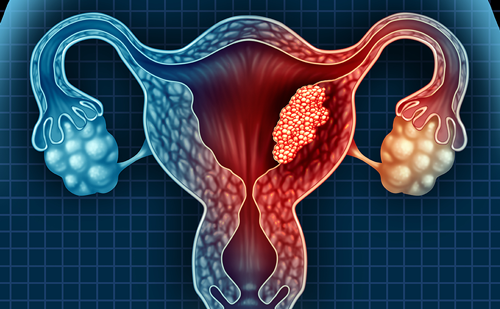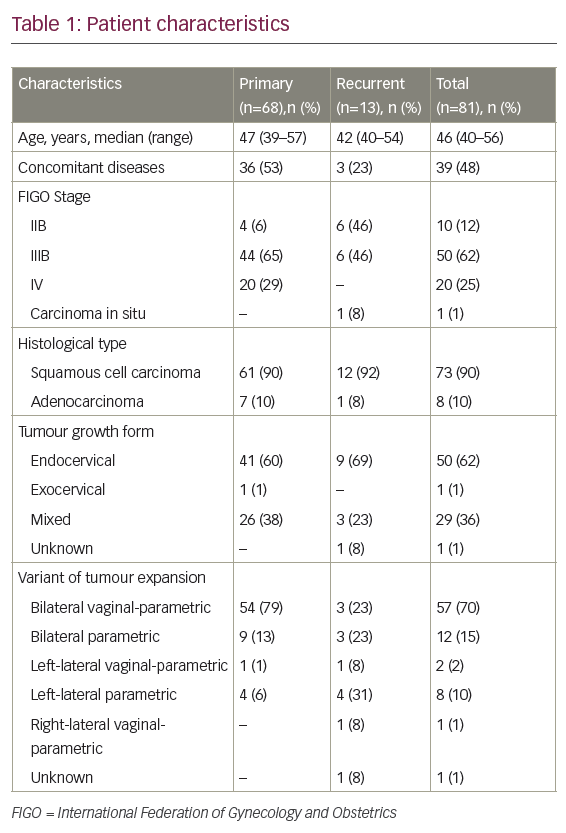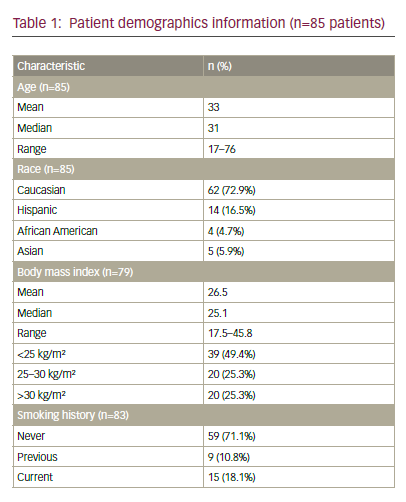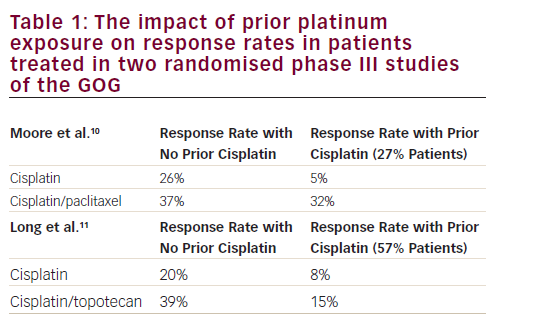Carcinoma of the vulva accounts for 4% of all female genital tract malignancies.1 The incidence in the UK is two per 100,000 female population.2 Vulval cancer is rare in young women with rates of more than one per 100,000 among women aged 25–44 years in the UK.2 In the US, 15% of vulval cancers are reported to occur in women <50 years of age.3,4 Prior studies have reported an incidence of 3.3% in women <35 years old,5 2.3% in women <40 years old and 6.1% in women <45 years old.6
In recent years, an increased incidence of vulval cancer in younger women has been observed.7–10 The UK incidence in younger women has doubled in the last three decades.2 Predisposing factors include infection with human papillomavirus (HPV) or herpes simplex virus type 2,11–13 vulval intra-epithelial neoplasia (VIN), lichen sclerosis, smoking11,14 and immunosuppression. HPV is strongly linked with tumours in young women, with an 11-fold increase reported for VIN and early-stage cancer in women <45 years of age with serological evidence of HPV infection.15 The increased incidence of vulval cancer is linked worldwide with an increasing incidence of VIN16,17 in younger women caused by HPV infection.18–20 Immunosuppression in young patients is identified as accelerating the progression of VIN to invasive vulval squamous cell carcinoma.21 There is an increased risk in HIV-positive women,10,21,22 with a strong relationship for women <30 years of age.23,24 HIV is also reported to cause rapid progression of these cancers.25 In the UK the annual number of newly diagnosed HIV individuals has increased by 182% over the past 10 years, with the majority of newly diagnosed persons aged between 25 and 44 years.26
Reports of either vulval carcinoma presenting during pregnancy,25,27–29 or of pregnancy following treatment for vulval cancer, are rare29–31 because the majority of women with the condition are perimenopausal with completed families, post-menopausal or rendered infertile or of reduced fertility following treatment with radiotherapy and chemotherapy.31 With the increasing incidence of HPV, VIN and HIV, and a concomitant increase in the incidence of vulval carcinoma in younger women, we are progressively more likely to encounter patients with either vulval carcinoma in pregnancy or pregnancy following treatment for vulval cancer. Given the paucity of available information to assist in managing these patients, and the increased likelihood of seeing this condition, a review of the management strategies in squamous cell vulval cancer associated with pregnancy is timely.
Method
We performed a computerised search (MEDLINE®/embase®) to identify all registered articles pertaining to squamous cell vulval carcinoma diagnosed or treated in pregnancy, and all cases of pregnancy following treatment for vulval cancer. The keywords used were all words with the phrase vulval/ vulvar carcinoma, squamous cell carcinoma, vulvectomy and pregnancy. In addition, cross-references of all selected articles were checked. Publications including patient details were further analysed for clinicopathological data, treatment regimens and maternal and neonatal outcomes. Publications not written in English, with incomplete reporting or where individual patients were reported in more than one publication were excluded.
Results
Twenty-four reports were identified in the literature pertaining to the diagnosis and management of vulval carcinoma in pregnancy/pregnancy following vulval cancer. One case report written in French was excluded.32 Two publications33,34 and six individual cases6,29 were excluded from analysis in view of either incomplete case reporting or the inability to assign individual clinicopathological data, treatment regimens or outcome to specific patients. A further report was excluded35 as the case details were repetitious of a prior published report.27 In total, 21 cases of vulval carcinoma in pregnancy and 13 cases of pregnancy following vulval cancer were considered. Publication dates ranged from 1940 to 2008.
Vulval Carcinoma in Pregnancy
Regarding the 21 cases of vulval carcinoma presenting during pregnancy or the post-natal period (up to three months post delivery), mean age at presentation was 29 years (range 17–39 years), the majority were multiparous (n=17; 80%), none were HIV-positive and one was immunocompromised (pregnancy-related bone marrow hypoplasia).36 The majority of women presented in the second (n=9, 43%) or third trimester (n=9, 43%), with only three women (14%) presenting in the post-natal period.9,37,38 The presence of a vulval mass (n=11, 52%) was the most common presenting complaint (n=5, 23%; vulval pruritus n=1, 5%; vulval pain 5%; vulval wart 5% incidental finding at delivery). All but one woman required some form of surgical management.
One woman diagnosed at 19 weeks’ gestation defaulted from surgery.25 In total, 11 of 18 women (61%) had a surgical procedure performed in the antenatal period: six of those (55%) were performed in the second trimester of pregnancy and five (45%) in the third trimester. Apart from the three women diagnosed in the post-natal period, one presenting at 16 weeks’ gestation39 had her surgery delayed until the post-natal period at approximately 22 weeks post diagnosis. She had stage IV disease and died 10 weeks post-treatment. Five further women diagnosed in the third trimester36,38,40–42 had their surgery delayed until the post-natal period. These patients were reported as alive and well at four to 60 months post-treatment; one was dead from disease at 48 months.
Following primary vulvar surgery in the antenatal period, two women had further post-natal lymphadenectomy surgery.27,43 The surgical complication rate for the 11 women operated on in the antenatal period was 36%, with two women having significant haemorrhage37,44 and two incurring groin seromas.45,46 The surgical complication rate for those operated on in the post-natal period was also 36% (one wound infection,37 one wound breakdown,38 one septicaemia39 and one groin haematoma).9
The majority of tumours were early stage (47% International Federation of Gynecology and Obstetrics [FIGO] I, 14% FIGO II, 24% FIGO III, 5% FIGO IV and 10% not recorded) and low grade (43% grade 1, 29% grade 2, 10% grade 3 and 18% not recorded). Background vulval pathology was inconsistently documented, with only four women (19%) noted as having VIN and one (5%) with HPV changes. Three women had pregnancy-related complications in the antenatal period: one had pregnancy-related bone marrow hypoplasia;36 one antepartum haemorrhage resulting in an emergency Caesarean section at 36 weeks’ gestation;6 and one pre-term labour and delivery at 29 weeks’ gestation.40 A further woman undergoing a radical vulvectomy and lymphadenectomy at 23 weeks also developed a recurrence of her carcinoma at 34 weeks’ gestation.47 Mode of delivery was documented in 20 women: eleven (55%) delivered vaginally (10 spontaneously, one by forceps); of the remainder, three (33%) had a Caesarean section for obstetrical reasons and six (66%) had a Caesarean section due to either the presence of vulval scarring (n=2) or the presence or diagnosis of vulval cancer (n=4). One woman had a bilateral episiotomy performed37 and one sustained a fourth-degree perineal tear.43
Six women underwent post-natal radiotherapy. Three further deliveries were recorded with two having a normal vaginal delivery37 and one Caesarean section 28 months after treatment.6 Maternal outcomes were recorded in 81%, although duration of follow-up was highly variable. Five women were recorded as dead from disease (range nine weeks to 48 months) and 12 were recorded as alive and well anywhere from four to 96 months (see Table 1).
Pregnancy Following Vulval Cancer
Regarding the 13 cases of pregnancy following vulval cancer, mean age at pregnancy was 31 years (range 19–39 years), the majority were nulliparous (n=9; 69%) and none were immunocompromised. All women had undergone prior vulval surgery with lymphadenectomy, and none had prior radiotherapy. The majority had a prior diagnosis of early-stage (FIGO I n=12 [92%] FIGO III n= 1 [8%]), low-grade (grade 1 n=9[69%]) squamous cell carcinoma of the vulva. Two women suffered antenatal complications: one unexplained intra-uterine death at 29 weeks’ gestation48 and one stillbirth6 born by emergency Caesarean section at 36 weeks’ gestation. In total, five women (38%) had a normal vaginal delivery. Of those delivered by Caesarean section, three (37%) were performed for obstetric reasons with the remainder performed for reasons related to the prior diagnosis of vulval cancer (n=4, 80% due to vulval scarring). Four further pregnancies were documented. Two were delivered by repeat Caesarean section, again due to vulval scarring, and two had normal vaginal deliveries. Maternal outcome was well documented with a mean follow-up period of 108 months (range 28–228 months). All women were reported as alive and well (see Table 2).
Discussion
Malignancy is uncommon in pregnancy and maternal vulval malignancy is rare. Diagnostic delay may occur when a low suspicion of malignancy exists in the younger patient age group, when confusion about symptomatology occurs in view of the physiological changes associated with pregnancy27 or if further investigation or treatment is postponed until the post-natal period. Delay may result in inadequate management and disease progression. All vulval symptoms in pregnancy (of a non-infective cause) should be taken seriously and malignancy considered as a potential diagnosis so that both appropriate referral and treatment may occur when necessary. Prior case reports emphasise the importance of vulval biopsy for clinically suspicious lesions in the younger or pregnant patient9,10,27–29,32,50,51 in order to detect cancer early and offer radical treatments where appropriate. Where clinically suspicious vulval lesions are identified, biopsy should be performed and, as vulval carcinoma may be associated with other lower genital tract neoplasia, the entire lower genital tract should be evaluated.
Vulval cancer in young patients can occur without apparent predisposing factors.7,51 Hormonal changes and alterations in the immune system may influence the dysplastic potential of HPV-infected cells.52,53 It is hypothesised that the ‘relative immunosuppressive state’ of pregnancy may allow HPV-infected areas of the vulva to rapidly progress through VIN to invasive carcinoma of the vulva.21,25,54We found only one immunocompromised patient (pregnancy-related bone marrow hypoplasia),36 and inconsistent documentation of background vulval pathology, hence no inferences can be made from this data.
When diagnosed with vulval malignancy a pregnant woman poses a significant challenge for both the obstetrician and gynaecological oncologist. Multidisciplinary management should be instituted from the outset. The paucity of reported cases and larger data series in the literature has prevented the development of accepted management plans for either vulval carcinoma presenting in pregnancy or pregnancy following treated vulval cancer. Management of such cases must be individualised27,40,47 with close attention paid to maternal age,40,50 gestational age,32,37,43 tumour characteristics (lesion site, size and stage),32,50,55 histopathological parameters (tumour grade, depth of invasion, lymphovascular space invasion (LVSI)32,40 and lymph-node status.32 The potential psychological impact of a diagnosis of vulval carcinoma in pregnancy and the potential longterm sequelae of therapeutic interventions in these younger patients must also be considered.50,56
When vulval carcinoma is diagnosed during pregnancy it is then recommended that the same treatment should be employed as in the non-pregnant state.29,45,50 When early-stage disease is diagnosed during the first trimester of pregnancy there is no indication for therapeutic abortion.36,44 In early-stage disease (FIGO Ia), wide local excision of the tumour alone may suffice as the risk of lymph node metastasis in these circumstances is negligible.57,58 For later-stage disease, radical surgery remains the mainstay treatment in the first and second trimesters,38,47 with groin node dissection advocated when the depth of invasion is >1mm (≥ FIGO Ib) or the maximum diameter of the tumour is >2cm (≥ FIGO II).58,59 The management of vulval cancer has been modified in recent years to reduce associated surgical morbidity. Prior reports recommend radical vulvectomy up to 36 weeks’ gestation.28,29,37,44,47 Delay after 36 weeks’ gestation into the postpartum period appears not to prejudice the course of disease.28,29,39,46,47,50 These recommendations hold well in the present day.
This literature review spans more than 65 years, hence we must take into account significant changes in the management of vulval cancer and changes in obstetrical and neonatal care. The practice of pelvic lymphadenectomy is now obsolete60 and, although surgery to the primary tumour should be radical enough to remove the tumour with adequate margins, triple incision techniques are now employed. Compared with more recent modifications in surgical practice, it is likely that some of the reported cases in the literature underwent more radical surgery than would be performed in today’s environment. As wide local excision of the primary tumour in early-stage disease may suffice, and lymphadenectomy is less extensive, consideration should be given in pregnancy to the use of regional as compared with general anaesthesia. Surgical morbidity is reported as being proportional to genital vascularity, which increases throughout pregnancy,27,38 with increased vascularity increasing the risk of surgical haemorrhage.39 Therefore, the risk for potential haemorrhage and increased risk of thromboembolic complications should be accounted for.
Inguinofemoral lymphadenectomy may be associated with considerable post-operative morbidity, hence the avoidance of more radical procedures where deemed unnecessary (i.e. in negative nodal disease). Currently, no non-invasive procedure available can reliably detect nodal metastases. Systematic review suggests that computerised tomography (CT), ultrasound, magnetic resonance imaging (MRI), positron emission tomography (PET) and fine-needle biopsy show inconsistent results and are not accurate enough for the routine assessment of groin node status.61 Sentinel node identification is currently the most promising diagnostic tool for the assessment of lymph node status in vulval carcinoma,62 –66 but its safety is still to be proven.58 Clearly in pregnancy contrast dyes and radiolabels should be used with caution, yet it has been reported that sentinel lymph node biopsy can be performed in pregnancy with negligible67,68 or very low risk69 to the foetus.
Adjuvant or neoadjuvant radiotherapy and chemotherapy may be utilised in the treatment of vulval carcinoma, with cisplatin and 5-fluorouracil (5-FU) being the more commonly investigated chemotherapeutic agents.70–75 When considering the use of either radiotherapy or chemotherapy in the pregnant patient, the risk of exposure to the foetus and neonate and the potential risks of delaying therapy to the mother in view of the pregnancy are highly significant matters. Radiotherapy should be avoided during pregnancy whenever possible76 and delayed until after delivery.77 All chemotherapy agents are potentially teratogenic.78 Although cisplatin is the most widely researched and most commonly used chemotherapy agent during human pregnancy,79 5-FU has been less widely studied. Studies in rats suggest that the neuroembyopathic effect of 5-FU is severe when given in the early and late phases of pregnancy,80–82 so it is advisable that the drug is avoided during pregnancy. Therapeutic abortion is a consideration for women presenting with advanced-stage or unresectable disease in early pregnancy.
The occurrence of vulval carcinoma in pregnancy or prior radical surgery for vulvar cancer may pose difficult decision-making when deciding upon the most appropriate mode of delivery. Prior reports advocate an attempt at normal vaginal delivery following radical surgery provided the vulval wounds are well healed,28,29,36,39,46,47,50,55 with delivery by Caesarean section advocated for obstetric indications only.38,49 When larger vulval lesions are detected near to the time of delivery, consideration must be taken as to the possible risk of laceration and haemorrhage associated with vaginal birth.7 Also if the lesion is close to the perineum then performance of episiotomy may be difficult due to potential encroachment onto the tumour.44 When vulval surgery is performed later in the second and third trimesters, vaginal delivery runs the risk of wound dehiscence or wound complications; in these circumstances, delivery by Caesarean section may be appropriate.39,44 Vulva scarring or prior vulval plastic reconstructive surgery may influence the decision to perform a Caesarean section.29,45,50 Delivery by Caesarean section may also be preferred by the woman.45,50
In the successfully treated vulval cancer patient there seems to be no contraindication to future pregnancy.36,39,40,50 Both vaginal delivery6,31 and Caesarean section6,49 have been reported. We found a 62% Caesarean section rate in those having had prior treatment for vulval cancer, where four (50%) were performed in view of significant vulval scarring. It is possible that maternal vulval carcinoma or prior treated vulval cancer may increase the likelihood of delivery by Caesarean section. Therefore, it seems pertinent that women are advised of this likely risk. The reported mortality rate for vulval carcinoma is lower in women who are between 25 and 44 years of age than in those >45 years of age.83 Five-year relative survival rates for vulval cancer have been shown to decrease with increasing age at diagnosis.84 It appears that pregnancy exerts no deleterious effects on the course of disease or prognosis.27,37,40,44 It is also likely that subsequent pregnancy following treatment for vulval cancer has no adverse effect and is not shown to increase the risk of recurrence.6,29,31We are unable to draw any conclusions regarding overall survival due to reporting variations in the duration of follow-up of these patients. For women diagnosed with vulval cancer in pregnancy, follow-up should run as standard vulval cancer management within a cancer centre. Examination of the groin and vulva should be performed during pregnancy as prior recurrence of disease during pregnancy has been reported.47
Conclusion
The diagnosis of vulval carcinoma during pregnancy is a rare event, as is pregnancy following treatment for vulval cancer. There is a suggestion that the incidence of vulval carcinoma is increasing in the younger age group. It is therefore likely that the incidence of vulval cancer in pregnancy will also increase. There is no single institution that can report a large series of maternal vulval cancer unless over an extended period of time, hence not allowing for significant changes in the management of vulval carcinoma and significant changes in obstetrical and neonatal care. Furthermore, multi-institutional co-operative groups could not study this issue. Only an extensive review could compile this information. We recommend that future case reporting contains detailed information on clinicopathological variables and treatment regimens. As longer-term maternal and neonatal outcomes are more difficult to substantiate in case reporting, the authors feel that data centralisation would be beneficial in identifying optimal management strategies in not only these rare tumours, but also in other malignant tumours diagnosed and treated during pregnancy. ■












